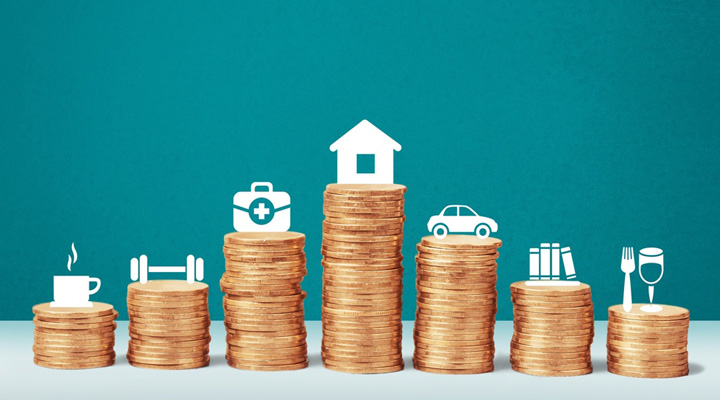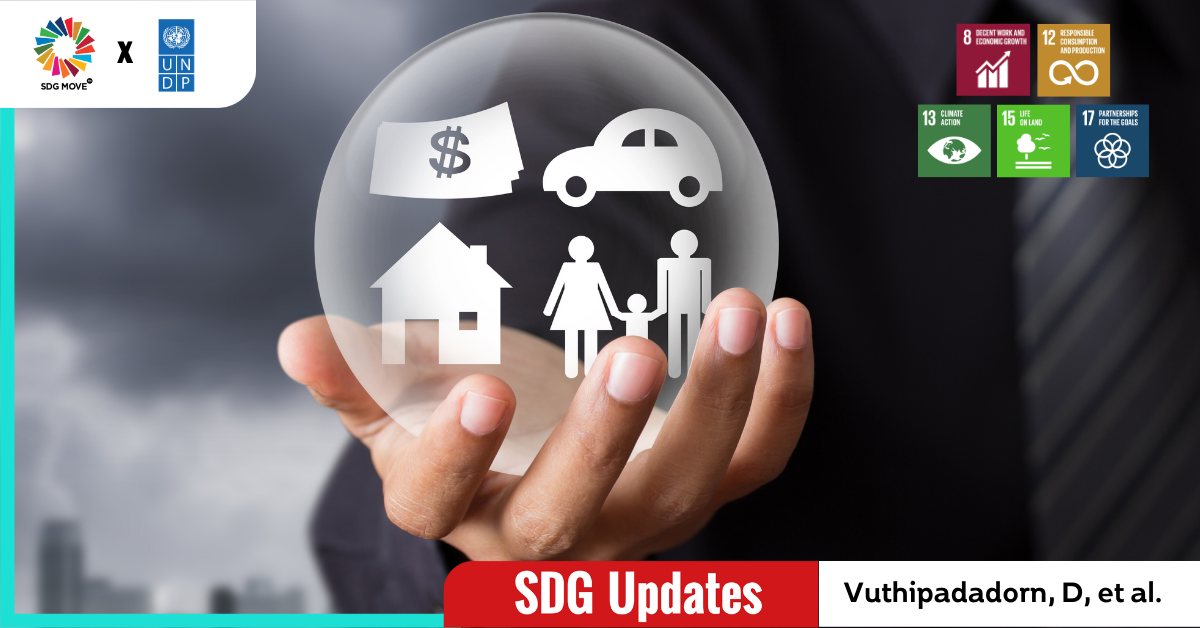Dadanee Vuthipadadorn
Anuk Serechetapongse
Thanawat Wachiratongkum
Do you know that Thailand is cited in the Thailand’s Climate Risk Country Profile[1] as one of the world’s ten most flood-affected countries and is ranked in the Germanwatch’s Global Climate Risk Report ninth on the list of the top ten countries most affected by weather-related loss events[2]?
Extreme weather events, in particular, resulted in the loss of lives of over 475,000 people globally, with monetary losses amounting to around US$ 2.56 trillion[3]. According to the Global Risks Report 2022, “The health of the planet” presented continuing concern both in the short, medium and long term, with “climate action failure”, “extreme weather”, and “biodiversity loss” ranking as the top three most severe risks over a 10-year horizon.
Thailand relies on its rich biodiversity and natural resources to support its people’s livelihoods and economic wellbeing. Natural capital, including forests, land, minerals, coastal areas, and marine species, have been the backbone of the country’s agriculture and tourism sectors, which collectively accounted for 40 % of GDP and nearly 60 % of total employment.
Thailand’s Climate Risk Country Profile 2021 observes an increase in temperature and annual precipitation across Thailand and reveals significant natural hazards including flood, drought, and cyclone.
A mega-flood in Thailand in 2011 alone caused widespread destruction and served as evidence of the country’s vulnerability to climate-related disasters. The flood affected more than 13 million people in 26 provinces, resulted in many deaths, and caused a total loss and damage of US$ 45.90 billion (THB 1.4 trillion)[4]. The tourism sector suffered from damage and losses from accommodation to local transport/tour operations of US$ 3.11 billion (THB 94.8 billion), and disaster impact on the financial and insurance sector was estimated to be US$ 3.78 billion (THB 115.3 billion)[5].
Disasters destroy tangible assets such as buildings and equipment – as well as human capital – and thereby deteriorate their production capacity. The economic damage caused by disasters varies. Capital assets and infrastructure such as housing, schools, factories and equipment, roads, dams and bridges are lost. Human capital is depleted due to the loss of life, the loss of skilled workers and the destruction of education infrastructure that disrupts schooling. Access to public services becomes limited or even stops, particularly in remote areas. The poorest and marginalized groups experience disproportionately greater loss and damage. If Thailand does not adapt, it is projected that climate change may cause the country’s Gross Domestic Product (GDP) to decline by 43.6 percent by 2048 (Swiss Re Institute 2021).

To manage disaster risks, the Thai government enacted the Disaster Prevention and Mitigation Act (DPM Act 2007) which sets out the main statutory framework for disaster risk management and disaster response and is supported by the National Disaster Prevention and Mitigation Plan (2015-2020) and provincial and district disaster risk management plans. At the national level, the National Disaster Prevention and Mitigation Committee (NDPMC) is the leading policy maker, chaired by the Prime Minister or a designated Deputy Prime Minister. At subnational levels, each province is to establish a Provincial Disaster Prevention and Mitigation Committee , led by its governor, and in the capital city, the Bangkok Metropolitan Administration Committee is chaired by the Bangkok Governor. Under this framework, responsible government agencies at the national-level, provincial-level and Bangkok Metropolitan Administration are expected to develop their own disaster prevention and mitigation plans and align them with the National Disaster Prevention and Mitigation plan to enable better preparedness and response capacity to disasters.
The Fiscal Policy Office (FPO) is responsible for fiscal risk management, including analyzing the impact of the changes in macroeconomic variables, including the impacts of natural disasters on Thai economy and government’s fiscal balance, tracking fiscal early warning system, and estimating foregone revenues from disasters. Furthermore, FPO acts as a secretariat of the Fiscal Discipline Committee, which determines the ratio of the Central Fund for Emergencies or Immediate Needs to the total budget, determining the size of the budget available for disaster management.
Notwithstanding the above framework and the existing risk assessment and management, Thailand is still ranked only 39th out of 48 countries in Germanwatch’s 2021 Global Climate Risk Index report in terms of its capacity to handle natural disasters.
Disaster risks are not yet systematically accounted for in budget formulation other than the established practiceof allocating 2.5%-3% of the total annual budget for emergencies and disaster response and management. The DMP Act 2007 itself makes no reference to risk transfer or insurance mechanisms as part of the risk management tools in the planning and budgeting of central and local governments. The current risk financing frameworks in Thailand rely on risk retention by using budget reserves, reallocation and contingency budgets to cover disaster-related expenditures. The only risk transfer solution supported by the government is the crop insurance program with the involvement of the insurance sector. As for public assets, the government sets aside budget to cover losses when occurring, instead of buying insurance from a third party.
In terms of inclusivity, Thailand shows low insurance penetration and density both in the life and non-life insurance markets. In 2020, the insurance penetration rate of Thailand was 5.3%, much lower than the global average of 7.4%. In particular, the non-life insurance penetration in Thailand was 1.9% compared to the global average of 4.1%.
Although Thailand introduced affordable insurance products for the poor and vulnerable groups or microinsurance[6], it represents less than 1% of the overall insurance policies with an annual premium of 0.2% (without crop insurance) of the overall market premium. In addition, these microinsurance products have mostly been sold only seasonally, mainly to coincide with the holiday events such as New Year or Song Kran seasons when the occurrence of accidents and perilous incidents are high. Crop insurance has the highest coverage with a penetration ratio of 72.3% of the total plantation areas and insuring 3.41 million farmers in 2021.

Most importantly, financial risk protection needs of informal workers, migrant workers[7], ageing citizens, and even micro, small and medium enterprises are still unmet by the current social protection and insurance systems. Financial protection against loss of income is a great need especially for informal workers. In addition, 40% of regular migrant workers[8] are excluded from the Social Security Fund and the Workmen’s Compensation Fund, and irregular migrant workers[9] do not have access to any of the formal social protection programmes apart from the Migrant Health Insurance Scheme[10].
Given the urgent need to better prepare for and respond to the severe impacts of climate change, disaster risks and other risks, it is essential that Thailand develops a more systematic and comprehensive risk management framework. Three key areas should be considered:
First, the country’s risk management strategy needs to be part of the overarching financing strategy for sustainable development.
Within the framework of the Tripartite Agreement between UNDP, the Insurance Development Forum (IDF) and the German government, UNDP has conducted a diagnostic study on inclusive insurance and risk finance for Thailand. It emphasizes the need to promote inclusive insurance and risk financing strategy to support the different phases of disaster risk management. This entails providing regulatory support to inclusive insurance (microinsurance) market development as part of the broader goal of providing financial protection for vulnerable populations as well as deploying risk transfer instruments such as insurance to free up public resources that can be used elsewhere. Insurance and risk finance should be part of Thailand’s Integrated National Financing Framework (INFF) to enhance the country’s resilience against future shocks and ensure the Leave No One Behind Principle. Thailand is on its way to becoming one of the pioneering UN member states to formulate a risk-informed integrated financing strategy for sustainable development.
Second, Thailand should strengthen the data management and analysis and utilize digital technology to support inclusive insurance and risk management.
As the impacts of risk, particularly disaster risks, are borderless, a unified database for inclusive insurance and risk financing is much required. The availability of timely data and effective analyses would facilitate the monitoring of the impacts of the risks, including frequency and severity of the risks, risk areas, potential victims, and estimated damage amounts.
Data analytics and digital technology can help increase the efficiency of the insurance processes. Utilization of data analytics and technology will enable insurers through new parametric insurance, satellite imaging and drone to facilitate the payout approval processes and this, in turn, will lead to a faster recovery for disaster victims. Digital technology could also be used to increase insurance penetration.
Finally, Thailand should leverage strategic partnerships with both national and international development actors in the public and private sectors to support disaster risk prevention and mitigation.
The whole-of-society approach is required to provide the much-needed transformation for Thailand to tackle the looming risks, from pandemic to climate change and disasters. In this regard, a Working Group on Insurance and Risk Finance for Thailand has been established, comprising the Office of Insurance Commission (OIC), the Fiscal Policy Office, the National and Economic Development Council, the Thai General Insurance Association (TGIA), the IDF and UNDP. The Working Group aims to synergize the expertise of both the public and private sectors, particularly the insurance industry, to provide insurance and risk finance solutions to mitigate the impact of risks on the poor and vulnerable populations, safeguarding Thailand’s progress towards the Sustainable Development Goals (SDGs).
In sum, insurance and risk financing have a critical role to play in delivering the SDGs[11] and building resilience by reducing vulnerabilities to impacts of health, socio-economic, and climate shocks. Given the currently low insurance penetration in the country, Thailand’s insurance industry still has much room to grow in key areas relevant to the thematic development priorities aligned with SDG progress e.g., microinsurance, crop insurance and disaster risk financing. Thailand’s climate vulnerability profile also calls for developing a risk-informed financing framework that improves the coherence between planning and financing, including risk financing. Thailand’s digital infrastructure should be leveraged to expand insurance penetration, supporting insurance inclusivity. This, together with the unified database and better data analytics, would significantly enhance the role of insurance and risk finance in mitigating and protecting people against risks, especially the most vulnerable populations. And finally, Thailand can benefit from stronger partnerships and collaboration with domestic and international development partners in driving its development pathway toward resilient and sustainable growth toward the 2030 Agenda.
Dadanee Vuthipadadorn (CO Chief Economist), Anuk Serechetapongse (CO Economist), and Thanawat Wachiratongkum (Research Assistant), UNDP Thailand
This article relevant to;
#SDG8 decent work and economic growth
– (8.3)Promote development-oriented policies that support productive activities, decent job creation, entrepreneurship, creativity and innovation, and encourage the formalization and growth of micro-, small- and medium-sized enterprises, including through access to financial services
– (8.10) Strengthen the capacity of domestic financial institutions to encourage and expand access to banking, insurance and financial services for all
#SDG12 responsible consumption and production
– (12.6) Encourage companies, especially large and transnational companies, to adopt sustainable practices and to integrate sustainability information into their reporting cycle
#SDG13 climate action
– (13.1) Strengthen resilience and adaptive capacity to climate-related hazards and natural disasters in all countries
– (13.2) Integrate climate change measures into national policies, strategies and planning
– (13.b) Promote mechanisms for raising capacity for effective climate change-related planning and management in least developed countries and small island developing States, including focusing on women, youth and local and marginalized communities
#SDG15 life on land
– (15.a) Mobilize and significantly increase financial resources from all sources to conserve and sustainably use biodiversity and ecosystems
#SDG17 partnerships for the goals
– (17.3) Mobilize additional financial resources for developing countries from multiple sources
[1] Climate Risk Country Profile: Thailand. The World Bank Group and Asian Development Bank,2021. https://www.adb.org/sites/default/files/publication/722251/climate-risk-country-profile-thailand.pdf
[2] Germanwatch’s Global Climate Risk Index 2021: Who Suffers Most from Extreme Weather Events? Whether-Related Loss Events in 2019 and 2000-2019. https://reliefweb.int/report/world/global-climate-risk-index-2021.
[3] Ibid.
[4] The 2011 flood caused damages and losses in more than 7.3 million rai of crops, 6.2 million heads of livestock and 177.1 thousand rai of fishery. Damage to buildings, equipment and machinery in the industry sector amounted to THB 513.9 billion.
[5] World Bank. 2012. Thai Flood 2011: Rapid Assessment for Resilient Recovery and Reconstruction Planning. World Bank, Bangkok. https://openknowledge.worldbank.org/handle/10986/26862 License: CC BY 3.0 IGO (The average exchange rate in 2011 of 30.5 baht per US dollars is used for the conversion to US dollars.)
[6] There are five main types of microinsurance products available in the Thai market, including motorcyclist accident, personal accident, student accident, residential fire, and crop insurance. Crop insurance covers rice and maize farmers and is the only type of microinsurance product that the government has subsidized the premiums for since 2011.
[7] Migrant workers contribute approximately 6.23% of Thailand’s total employment in 2021(National Statistic Office, 2022). They are predominately employed in low-paid jobs, including fishing, agriculture, construction, manufacturing, domestic work, and other services.
[8] Regular migrant workers are non-Thai people who have a work permit, visa, or other documents whichprovide a legal right for their stay in Thailand.
[9] Irregular migrant workers in contrast do not have documentation providing a legal right for their stay in Thailand.
[10] IOM, ILO, UNICEF, UNWOMEN, Social Protection for Migrant Workers and Their Families in Thailand (Thailand Social Protection Diagnostic Review: Social Protection for Migrant Workers and Their Families in Thailand | IOM Publications Platform)
[11] From UNDP’s SDG Investor Map Report, insurance can contribute to the sustainable development goals of no poverty (SDG 1), decent work and economic growth (SDG 8), and reduced inequality (SDG 10). In addition, it can contribute to reducing gender inequality (SDG 8).
Atirut Duereh, copyreader
Pimnara Intaprasert, editor













One thought on “SDG Updates | Insurance and risk finance solutions to enhance Thailand’s resilience”